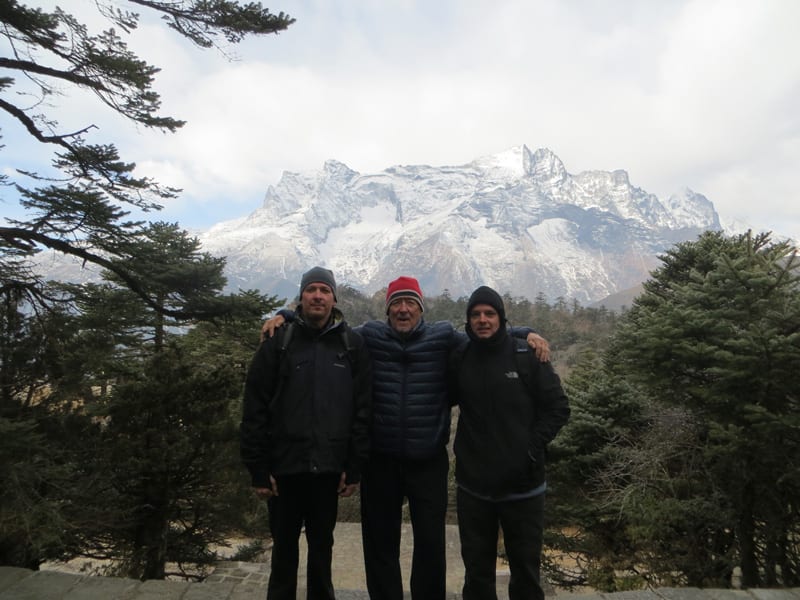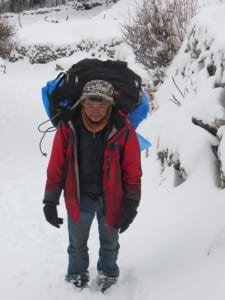


Most people don’t wake up one day and say, “Hey, let’s go climb Mount Everest,” but that is just about how the story of alum Bob Patrick’s ’72 Himalayan adventure began. For him and his two sons, Robert Jr. and Andy, venturing is in their blood. Through the years Bob and his son have gone on many hiking adventures, spending valuable time together and challenging themselves to new heights. In the case of Mt. Everest, you really can’t get any higher.
Bob is used to climbing to great heights. After starting the Abbey in 1963, he dropped out to serve his country and join the Navy. The Navy adventure not only helped him pay for college, but also soon resulted in a wife and two kids, which motivated him to resume his studies at the Abbey and work toward graduation. On the road to graduation, while supporting a family, Bob needed a little help. Thankfully, Fr. Cuthbert Allen recognized his struggle and helped find the family man/student a job at a local textile mill, whose VP was an Abbey alum. With the support of Fr. Cuthbert and the Abbey faculty and staff, Bob graduated in 1972.
A couple of years ago, Bob’s older son Robert proposed the idea of heading to Nepal, finding a Sherpa and climbing Everest. At that time Nepal was dealing with the effects of a massive earthquake so the idea was put on hold, only to be resurrected and put into action this past March. They found a trekking company and started preparation for the great hike. Bob prepared himself physically, or so he thought. “I trained for six months, worked out in a gym every day, only to find out it wasn’t nearly enough. I should have done the stair stepper six hours a day for six months,” he says.
The climb was challenging, and making it to the start of the climb was in itself quite the adventure. The threesome flew into Katmandu and then took a small plane from there to Lukla where the trek began. “It has the most dangerous airport in the world,” Bob says. “The plane drops out of the sky and lands on an area less than a football field.” The walk from there is just up and up. With the help of the Sherpa and two porters to carry their equipment and food, they began. “It was cold as ‘hell’—no heat, ice on the floor in the mornings of where we slept, and you’re hiking in 8-10 inches of snow all the time. We had small packs but it was quite a load to carry. My guide was only about 5’ 2” but could carry 150 pounds without blinking an eye; it was his career.”
There are tea houses along the way to give you a respite, but Bob recalls that the trail itself is only about 4-6 feet wide. With such a narrow way, it is common to get sidelined by suppliers who use yaks to supply the small towns along the way. Moving out of the way of a yak on the side of a mountain is no small feat. They hiked for 10 days before Bob was beset with the most difficult part of his trip, sinusitis and a 102 degree fever. Coming very close to the base camp, Bob could not go on. With the help of his porter, he hiked 7-8 days back down the mountain only to be helicoptered back to Lukla and then on to Katmandu and home.
to get sidelined by suppliers who use yaks to supply the small towns along the way. Moving out of the way of a yak on the side of a mountain is no small feat. They hiked for 10 days before Bob was beset with the most difficult part of his trip, sinusitis and a 102 degree fever. Coming very close to the base camp, Bob could not go on. With the help of his porter, he hiked 7-8 days back down the mountain only to be helicoptered back to Lukla and then on to Katmandu and home.
But his two sons made it all the way to the base camp, 18,000 feet up. “Going to a place like that makes you appreciate the simple things like salt and pepper, hot water and a clean bed to sleep in,” Bob says. “I would recommend everybody live in the woods awhile, just to have that same appreciation.”
Bob recalls how he began at the Abbey, another trek that also started and stopped. Fr. Martin, the treasurer at one time, was a kind of uncle to him – his mother, an orphan, was raised by Fr. Martin’s family. In 1963, she asked Bob if he wanted to apply to the Abbey. “The drinking age is 18 in North Carolina,” she said. “I’m in,” Bob replied. “I figured. They’re coming tomorrow to pick you up,” his mother said.
“It turned out to be a really good experience,” Bob says. After the Navy, a wife and kids, he finally did reach his goal of graduating from the Abbey. Kind of like trying to climb a mountain.


